Oily skin can be a challenge to manage, especially when it comes to acne and breakouts. While there are many over-the-counter spot treatments available, some people prefer to use natural remedies to avoid harsh chemicals and synthetic ingredients. Fortunately, there are many DIY homemade spot treatment recipes for oily skin that can help reduce inflammation, unclog pores, and promote clear skin.

These homemade spot treatment recipes often use everyday ingredients that are easily accessible and affordable. For example, honey is a popular ingredient in many DIY skincare recipes due to its antibacterial properties and ability to soothe and moisturize the skin. Other ingredients commonly used in homemade spot treatments for oily skin include tea tree oil, witch hazel, apple cider vinegar, and aloe vera.
While DIY homemade spot treatment recipes can be effective for oily skin, it’s important to note that everyone’s skin is different, and what works for one person may not work for another. It’s also essential to patch test any new ingredients before applying them to the face and to follow proper skincare practices, such as cleansing and moisturizing regularly. With that said, let’s take a look at some of the best DIY homemade spot treatment recipes for oily skin that you can make at home using natural ingredients.
- Tea Tree Oil and Aloe Vera Spot Treatment
- Witch Hazel and Lemon Juice Blemish Dab
- Apple Cider Vinegar and Water Pimple Solution
- Honey and Cinnamon Overnight Dot
- Green Tea and Honey Anti-Acne Paste
- Baking Soda and Lemon Spot Reducer
- Neem Oil and Coconut Oil Zit Zapper
- Turmeric and Yogurt Healing Mask
- Garlic and Water Spot Clarifier
- Aspirin and Water Anti-Inflammatory Treatment
- Clay and Apple Cider Vinegar Pore Minimizer
- Peppermint Oil and Water Cooling Spot Therapy
- Tomato Juice and Aloe Vera Scar Diminisher
- Chamomile Tea and Honey Soothing Gel
- Lavender Oil and Jojoba Oil Gentle Acne Touch
- Rosewater and Tea Tree Oil Tonic
- Epsom Salt and Water Purifying Solution
- Sea Salt and Water Healing Spray
- Orange Peel and Water Brightening Treatment
- Grapefruit Seed Extract and Glycerin Serum
- Cucumber and Lemon Refreshing Spot Corrector
Tea Tree Oil and Aloe Vera Spot Treatment

Tea tree oil and aloe vera are both known for their antibacterial and anti-inflammatory properties, which make them effective in treating acne. Tea tree oil helps to kill the bacteria that cause acne, while aloe vera soothes the skin and reduces inflammation.
Ingredients
- 3 drops of tea tree oil
- 2 tablespoons of aloe vera gel
- Small bowl of warm water
Recipe
- Dilute the tea tree oil by mixing it with the aloe vera gel.
- Add the mixture to a small bowl of warm water and mix well.
- Gently cleanse the face with the solution, making sure to rinse well.
- Apply the solution to the affected areas using a cotton swab or pad.
- Leave on for 10-15 minutes and then rinse off with warm water.
- Pat your face dry with a clean towel.
This spot treatment can be used once or twice a day, depending on the severity of the acne. It is important to dilute the tea tree oil with a carrier oil or aloe vera gel, as using it undiluted can cause skin irritation.
It is recommended to perform a spot test before using this treatment on your face, as some people may be allergic to tea tree oil. If you experience any redness, itching, or swelling, discontinue use immediately.
Overall, tea tree oil and aloe vera spot treatment is a natural and effective way to treat acne. It is also affordable and easy to make at home.
Witch Hazel and Lemon Juice Blemish Dab

For those with oily skin, blemishes can be a common problem. Fortunately, there are many DIY spot treatments that can help reduce the appearance of blemishes and prevent future breakouts. One effective option is the Witch Hazel and Lemon Juice Blemish Dab.
Ingredients
To make this spot treatment, you will need:
- Witch hazel
- Lemon juice
Both of these ingredients are known for their ability to reduce inflammation and fight bacteria, making them ideal for treating blemishes.
Recipe
To make the Witch Hazel and Lemon Juice Blemish Dab, follow these steps:
- Mix equal parts witch hazel and lemon juice in a small bowl or container.
- Using a cotton swab or pad, dab the mixture onto blemishes.
- Leave the mixture on for 10-15 minutes, then rinse off with warm water.
- Repeat up to twice daily as needed.
It’s important to note that lemon juice can be irritating to some skin types, so it’s a good idea to do a patch test before using this treatment on your face. Additionally, because lemon juice can make your skin more sensitive to the sun, it’s important to use sunscreen or avoid sun exposure after using this treatment.
Overall, the Witch Hazel and Lemon Juice Blemish Dab is a simple and effective DIY spot treatment for those with oily skin. By combining the anti-inflammatory and antibacterial properties of witch hazel and lemon juice, you can help reduce the appearance of blemishes and prevent future breakouts.
Apple Cider Vinegar and Water Pimple Solution
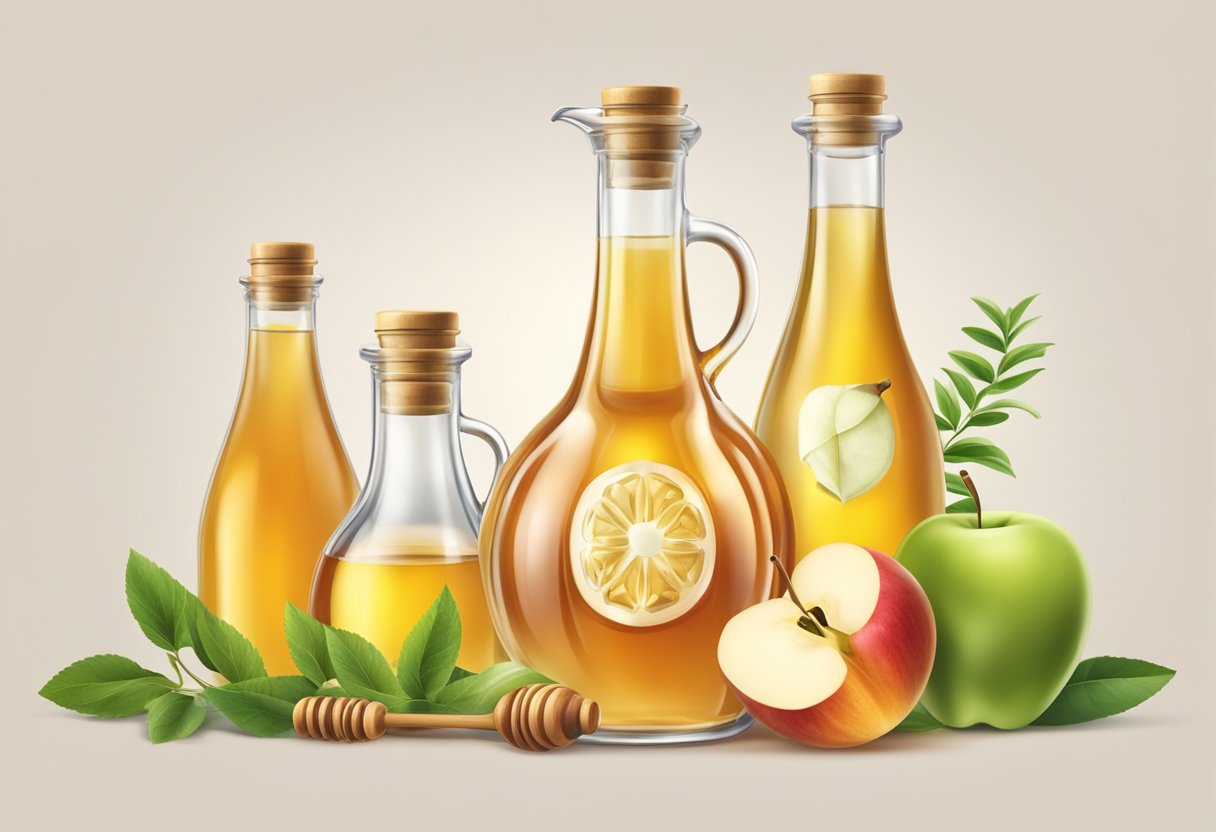
Apple cider vinegar (ACV) has been shown to balance the skin’s pH, fight acne-causing bacteria, and provide exfoliating and astringent benefits. When combined with water, it creates an effective spot treatment for oily skin.
Ingredients
- 1 tablespoon apple cider vinegar
- 2 tablespoons water
Recipe
- Mix the apple cider vinegar and water in a small bowl.
- Dip a cotton ball into the mixture and apply it directly to the pimple.
- Let it sit for 10-15 minutes, then rinse off with water.
- Repeat once or twice daily until the pimple disappears.
It is important to note that undiluted apple cider vinegar can be too strong for the skin and cause irritation. Therefore, it is recommended to always dilute it with water before using it as a spot treatment.
Overall, this simple and affordable DIY pimple solution can be a great addition to any oily skin care routine.
Honey and Cinnamon Overnight Dot

Honey and cinnamon are two ingredients that have been used for centuries to treat various skin conditions, including acne. Honey is a natural antibacterial agent that helps to kill the bacteria that cause acne, while cinnamon is a natural anti-inflammatory that helps to reduce redness and swelling.
Ingredients List
- 2 tablespoons of honey
- 1 tsp of cinnamon
Recipe
- Mix 2 tablespoons of honey with 1 tsp of cinnamon in a clean container, such as a small bowl.
- Use a medical-grade honey, such as Manuka or Revamil, if possible, since these contain higher concentrations of antimicrobial substances than other honeys.
- Apply the mixture directly to the affected area using a cotton swab or Q-tip.
- Leave the mixture on overnight and rinse off in the morning with lukewarm water.
- Repeat this process every night until the acne disappears.
It is important to note that honey and cinnamon may not work for everyone, and it may take some time to see results. It is also important to use a medical-grade honey to ensure that you are getting the most effective treatment possible.
In addition to using honey and cinnamon, there are many other natural ingredients that can be used to treat acne. Some of these include baking soda, aspirin, and lemon juice. It is important to do your research and find the ingredients that work best for your skin type and individual needs.
Green Tea and Honey Anti-Acne Paste
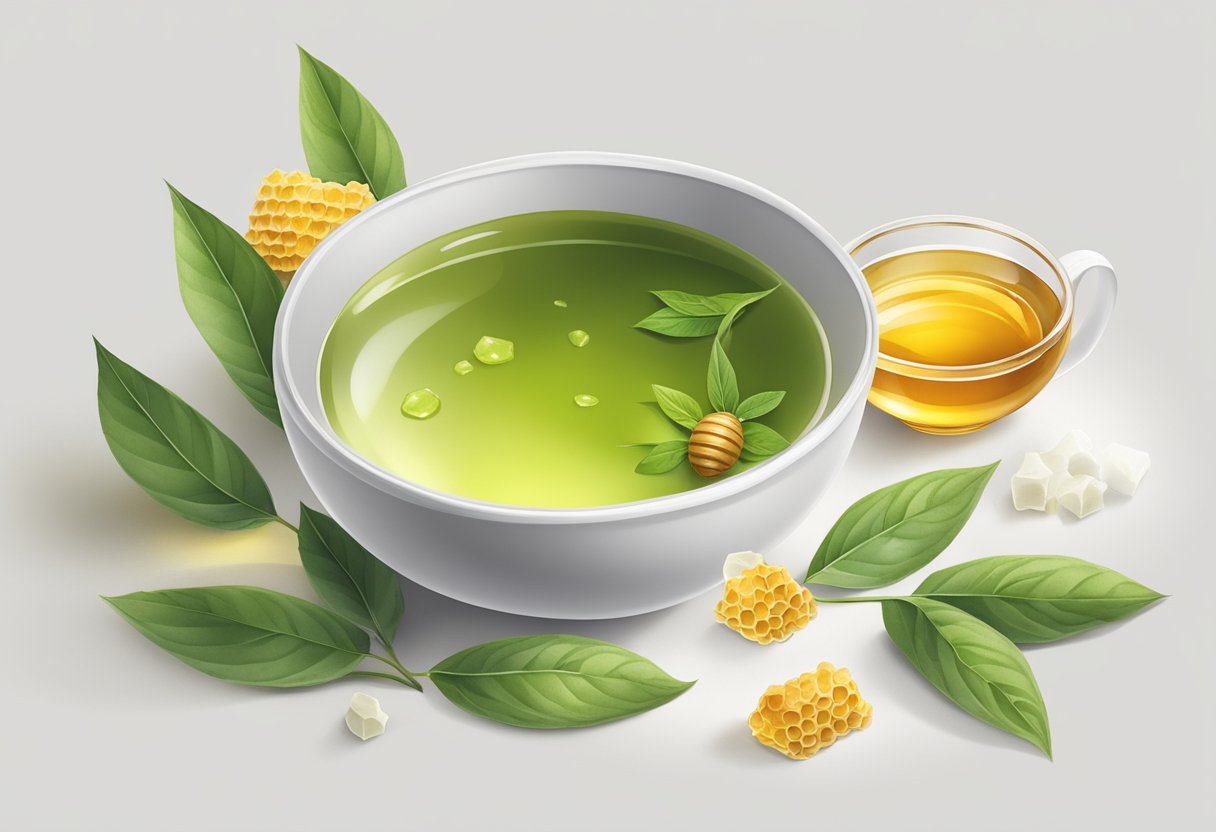
Green tea and honey are two natural ingredients that have been used for centuries to improve skin health. They both have anti-inflammatory and antibacterial properties that make them effective in treating acne and reducing inflammation. When combined, they create a powerful anti-acne paste that can help clear up oily skin.
Ingredients List
- 1 green tea bag
- 1 tablespoon of organic raw honey
Recipe
- Steep the green tea bag in hot water for 3-5 minutes.
- Remove the tea bag from the water and let it cool.
- Cut open the tea bag and empty the contents into a small bowl.
- Add the honey to the bowl and mix well.
- Apply the paste to your face, focusing on areas with acne.
- Leave the paste on for 10-15 minutes.
- Rinse off with warm water and pat your face dry.
This green tea and honey anti-acne paste is gentle enough to use daily and can be stored in the refrigerator for up to one week. Green tea contains antioxidants that help protect against free radicals and promote healthy skin, while honey helps to soothe and moisturize the skin. Together, they make a powerful combination that can help improve the overall health and appearance of your skin.
Baking Soda and Lemon Spot Reducer

Baking soda and lemon are two ingredients that are commonly used in DIY spot treatment recipes for oily skin. They are known for their ability to reduce the appearance of spots and blemishes, and can be easily found in most kitchens.
Ingredients
Here are the ingredients you will need to make this spot reducer:
- 1 tablespoon of baking soda
- 1/2 tablespoon of lemon juice
- 1/8 tablespoon of coconut oil
- 2 drops of tea tree essential oil (optional)
Recipe
Here are the steps to make the baking soda and lemon spot reducer:
- Mix the baking soda, lemon juice, coconut oil, and tea tree essential oil (if using) in a small bowl.
- Stir the mixture until it forms a paste.
- Apply the paste to the affected area using a cotton swab or your fingertips.
- Leave the paste on for 10-15 minutes.
- Rinse the paste off with lukewarm water.
- Pat your skin dry with a clean towel.
How It Works
Baking soda is a natural exfoliant that helps to remove dead skin cells and unclog pores. It also has anti-inflammatory properties that can help to reduce redness and swelling.
Lemon juice contains vitamin C, which is a powerful antioxidant that can help to brighten and even out skin tone. It also has natural bleaching properties that can help to lighten dark spots and blemishes.
Coconut oil is a natural moisturizer that can help to hydrate and nourish the skin. It also has antimicrobial properties that can help to prevent infection and promote healing.
Tea tree essential oil is a natural antiseptic that can help to kill bacteria and reduce inflammation. It is often used in spot treatment recipes for oily skin because of its ability to reduce the appearance of blemishes and prevent future breakouts.
Neem Oil and Coconut Oil Zit Zapper

Neem oil and coconut oil are both natural ingredients that have been used for centuries to treat various skin conditions. When combined, they create a powerful zit zapper that can help to reduce inflammation and prevent future breakouts.
Ingredients
- 1 tablespoon of neem oil
- 1 tablespoon of coconut oil
- 3 drops of tea tree oil
Recipe
- Combine the neem oil and coconut oil in a small bowl and mix well.
- Add the tea tree oil and stir until well blended.
- Using a cotton swab or clean fingertips, apply the mixture directly to the affected area.
- Leave on for 10-15 minutes, then rinse off with warm water.
How it Works
Neem oil is known for its antibacterial and anti-inflammatory properties, which makes it an effective treatment for acne. Coconut oil is also antibacterial and can help to moisturize the skin. Tea tree oil is a natural antiseptic and can help to reduce inflammation and redness.
When combined, these ingredients create a powerful zit zapper that can help to reduce the appearance of acne and prevent future breakouts. The neem oil and coconut oil work together to moisturize and soothe the skin, while the tea tree oil helps to kill bacteria and reduce inflammation.
Overall, the neem oil and coconut oil zit zapper is a natural and effective way to treat acne. It is gentle on the skin and can be used regularly to maintain healthy skin.
Turmeric and Yogurt Healing Mask
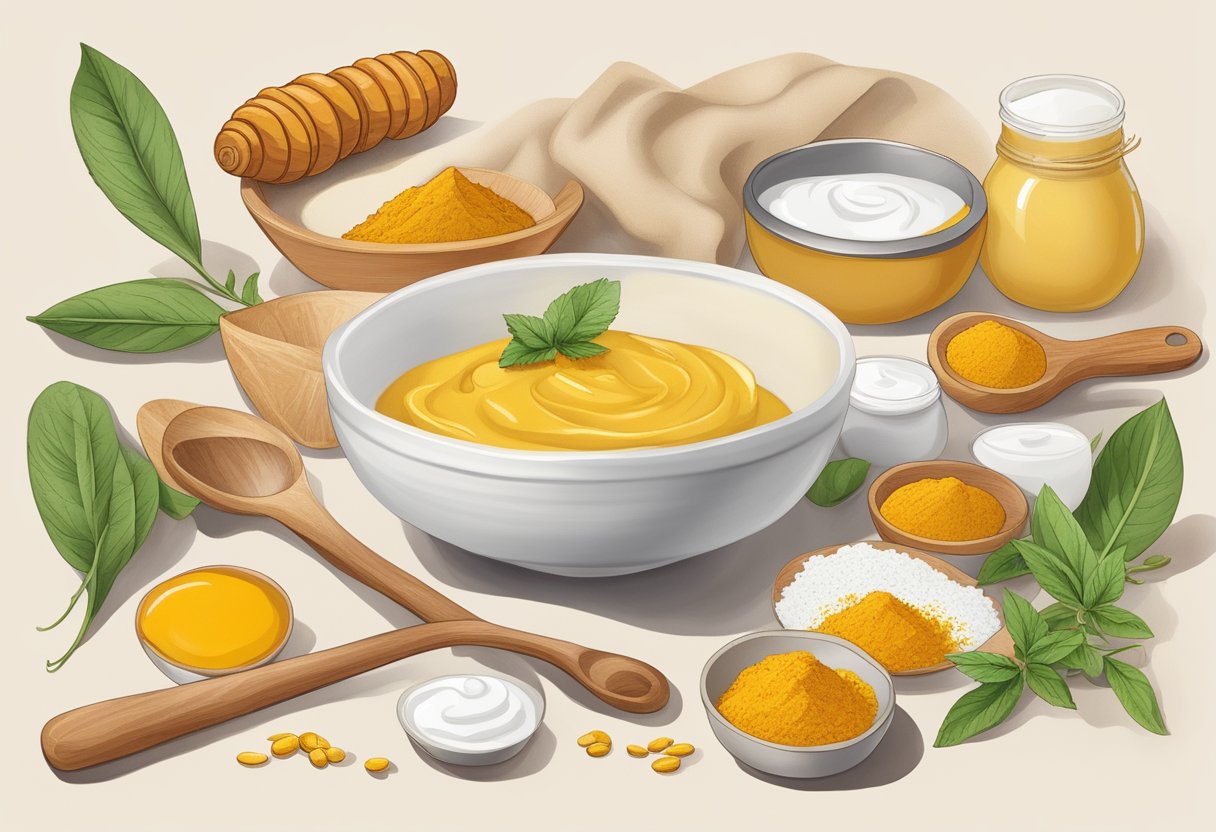
Turmeric and yogurt are two ingredients that are renowned for their skin-healing properties. When combined, they create a powerful face mask that can help to reduce inflammation, soothe irritated skin, and leave your complexion looking brighter and more radiant.
Ingredients:
- 1 tablespoon of turmeric powder
- 1 tablespoon of plain yogurt
Recipe:
- Mix the turmeric powder and plain yogurt together in a small bowl until well combined.
- Apply the mixture to your face, taking care to avoid the eye area.
- Leave the mask on for 10-15 minutes, or until it has dried completely.
- Rinse the mask off with warm water and pat your face dry with a clean towel.
This mask is perfect for oily skin types as it helps to regulate sebum production while also providing a gentle exfoliation. The turmeric acts as a natural antiseptic, helping to kill the bacteria that can cause acne, while the lactic acid in the yogurt helps to gently dissolve dead skin cells and unclog pores.
To get the most out of this mask, it is recommended to use it once or twice a week. However, it is important to note that turmeric can stain clothing and surfaces, so it is best to wear an old shirt and use a dark-colored towel when applying this mask.
Overall, the turmeric and yogurt healing mask is a simple and effective way to give your skin a much-needed boost. With regular use, it can help to reduce inflammation, improve skin texture, and leave your complexion looking brighter and more youthful.
Garlic and Water Spot Clarifier

Garlic is a natural antifungal, antiviral, and antibacterial agent that can help reduce inflammation and redness associated with acne. When combined with water, it can be used as a spot treatment to help clarify skin and reduce the appearance of blemishes.
Ingredients
- 1 garlic clove
- 1/4 cup water
Recipe
- Peel and chop the garlic clove into small pieces.
- Add the chopped garlic to a small bowl.
- Pour the water over the garlic and let it sit for 5-10 minutes.
- Dip a cotton ball into the garlic water and apply it directly to the affected area.
- Leave the solution on for 10-15 minutes before rinsing it off with warm water.
- Repeat this process once a day until the blemish has cleared up.
Note: Garlic can be irritating to some skin types, so it’s essential to do a patch test before applying it to the face. If you experience any redness or irritation, discontinue use immediately.
Aspirin and Water Anti-Inflammatory Treatment
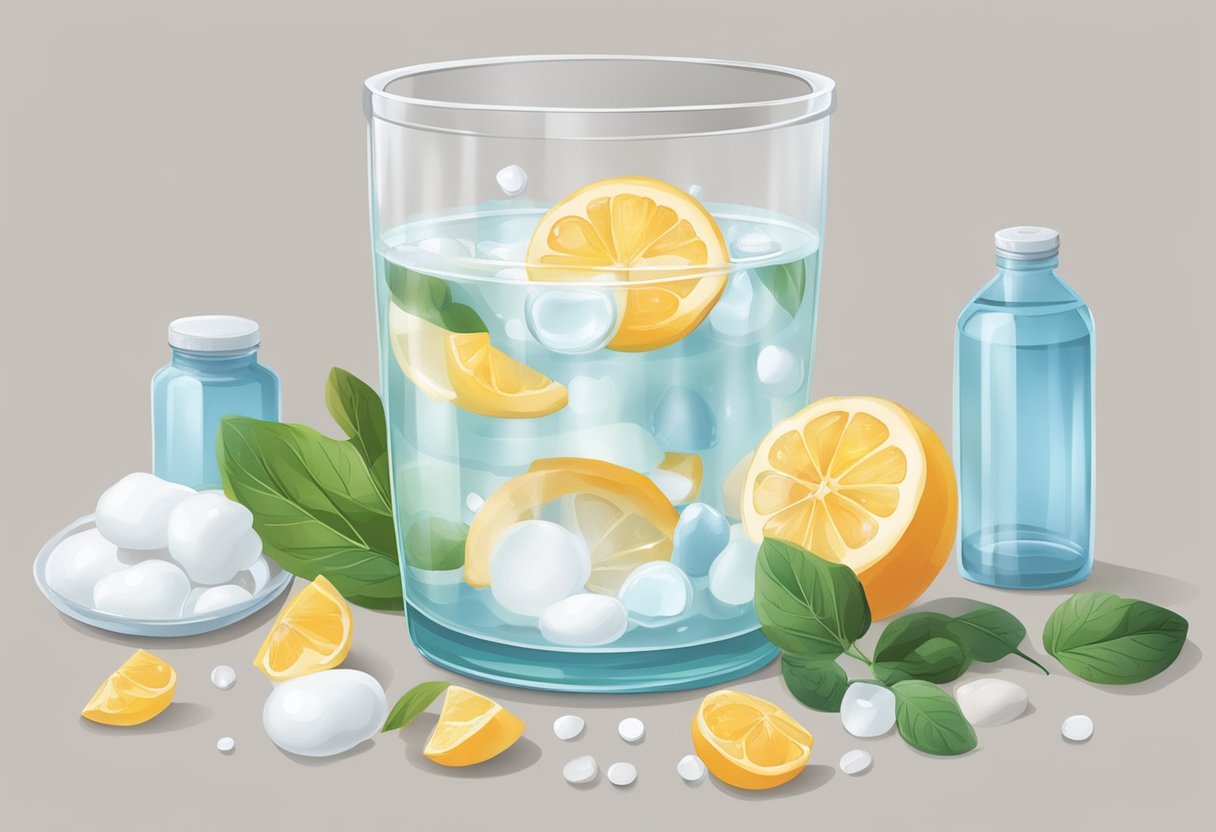
Aspirin is an anti-inflammatory medication that can help reduce the redness and swelling associated with pimples. This is because aspirin contains salicylic acid, which is a common ingredient in many acne treatments.
To make an aspirin and water anti-inflammatory treatment, you will need:
- 2-3 aspirin tablets
- Water
Here’s how to make it:
- Crush 2-3 aspirin tablets into a fine powder.
- Add a few drops of water to the powder to create a paste.
- Apply the paste directly to the pimple.
- Leave the paste on for 10-15 minutes.
- Rinse off the paste with warm water.
This treatment can be used once a day until the pimple is gone. It is important to note that aspirin should not be used by people who are allergic to it or by women who are pregnant.
Overall, aspirin and water anti-inflammatory treatment can be a simple and effective way to reduce the appearance of pimples. However, it is important to remember that everyone’s skin is different and what works for one person may not work for another.
Clay and Apple Cider Vinegar Pore Minimizer

Oily skin is more prone to acne and blackheads because excess oil clogs the pores. Clay masks are an excellent way to remove impurities from the skin and unclog the pores. Apple cider vinegar is another effective ingredient that helps to balance the skin’s pH levels and minimize the appearance of pores.
Ingredients
- 1 tablespoon of bentonite clay
- 1 tablespoon of apple cider vinegar
- 1-2 drops of tea tree oil (optional)
Recipe
- In a small bowl, mix the bentonite clay and apple cider vinegar until it forms a smooth paste.
- Add a few drops of tea tree oil to the mixture if you want to enhance the mask’s acne-fighting properties.
- Apply the mask to your face, avoiding the eye area, and leave it on for 10-15 minutes.
- Rinse the mask off with warm water and pat your face dry with a clean towel.
Bentonite clay is a natural ingredient that is rich in minerals and has excellent detoxifying properties. It helps to remove impurities from the skin and unclog the pores. Apple cider vinegar has natural antibacterial and antifungal properties that help to fight acne-causing bacteria. It also helps to balance the skin’s pH levels, which can reduce the appearance of pores.
This mask is an excellent way to deep clean your pores and minimize their appearance. It is suitable for all skin types, but it is especially beneficial for oily and acne-prone skin. Use this mask once a week for best results.
Peppermint Oil and Water Cooling Spot Therapy

Peppermint oil and water cooling spot therapy is a simple and effective way to treat oily skin. This DIY treatment is easy to make and can be used to soothe and cool irritated skin.
Ingredients
- Young Living Peppermint essential oil
- Distilled water
- 2 oz. spray bottle
Recipe
- Drip 3-5 drops of Young Living Peppermint essential oil in a 2 oz. spray bottle.
- Fill the bottle with distilled water.
- Shake well to combine.
- Spritz on your chest, arms, feet or neck and COOL down!
Peppermint oil has natural cooling properties that help to reduce inflammation and soothe irritated skin. When combined with water, it creates a refreshing mist that can be used to cool down and refresh oily skin.
This peppermint oil and water cooling spot therapy is perfect for use during hot summer months or after a workout. It can also be used as a quick pick-me-up during a long day at work.
Overall, this DIY treatment is a simple and effective way to treat oily skin and keep it feeling cool and refreshed.
Tomato Juice and Aloe Vera Scar Diminisher

Tomatoes are a great source of vitamin C and antioxidants, which can help reduce inflammation and promote healing. Aloe vera also has anti-inflammatory properties and can help soothe irritated skin.
To make a scar diminisher using tomato juice and aloe vera, the following ingredients are needed:
Ingredients
- 1 tablespoon of fresh tomato juice
- 1 tablespoon of aloe vera gel
Recipe
- Mix the tomato juice and aloe vera gel together in a small bowl.
- Apply the mixture to the affected area and leave it on for 10-15 minutes.
- Rinse off with cool water and pat dry.
This treatment can be used once a day until desired results are achieved. However, it is important to note that results may vary and it is always best to consult with a dermatologist before trying any new treatments.
In addition to this treatment, it is important to maintain a healthy skincare routine and avoid picking at any scars or blemishes to prevent further damage to the skin.
Chamomile Tea and Honey Soothing Gel

Chamomile tea and honey have long been known for their soothing properties, making them a perfect combination for a homemade spot treatment gel. This gel can help reduce redness, inflammation, and irritation caused by acne and other skin conditions.
Ingredients
- 2 chamomile tea bags
- 1 tablespoon of honey
- 1 teaspoon of aloe vera gel
- 1 teaspoon of witch hazel
- 1 drop of tea tree oil
Recipe
- Steep the chamomile tea bags in 1/2 cup of boiling water for 10 minutes.
- Remove the tea bags and let the tea cool down.
- Add 1 tablespoon of honey, 1 teaspoon of aloe vera gel, and 1 teaspoon of witch hazel to the tea.
- Stir the mixture until all ingredients are well combined.
- Add 1 drop of tea tree oil and mix well.
- Transfer the mixture to a clean container with a lid.
- Store the gel in the refrigerator for up to 2 weeks.
To use the chamomile tea and honey soothing gel, apply a small amount to the affected area using a clean fingertip or cotton swab. Leave it on for 10-15 minutes before rinsing it off with warm water. Repeat the process twice a day for best results.
Note: This gel is suitable for oily skin types. If you have sensitive skin, do a patch test before using it on your face.
Lavender Oil and Jojoba Oil Gentle Acne Touch

Lavender oil and jojoba oil are two of the best oils for acne-prone and oily skin. They are gentle on the skin and have anti-inflammatory and antibacterial properties that can help reduce inflammation and prevent breakouts.
To make a gentle acne touch using lavender oil and jojoba oil, you will need the following ingredients:
- 1 tablespoon jojoba oil
- 1-2 drops lavender oil
To make the touch, simply mix the jojoba oil and lavender oil in a small bowl. Apply the mixture to the affected area with a cotton swab or your fingers. Leave it on for at least 15 minutes before rinsing it off with warm water.
Jojoba oil is a great carrier oil for lavender oil because it is similar in composition to the natural oils produced by the skin. This means that it is easily absorbed and can help regulate the skin’s oil production.
Lavender oil is known for its calming and soothing properties, which can help reduce redness and irritation associated with acne. It also has antimicrobial properties that can help kill acne-causing bacteria.
Overall, the lavender oil and jojoba oil gentle acne touch is a simple and effective way to treat acne without harsh chemicals or prescription medications.
Rosewater and Tea Tree Oil Tonic

Rosewater and tea tree oil are a powerful combination for treating oily skin and acne. Rosewater has anti-inflammatory and anti-bacterial properties that help soothe and calm irritated skin. Tea tree oil is a natural antiseptic that helps fight acne-causing bacteria and reduces inflammation.
Ingredients
| Ingredient | Amount |
|---|---|
| Rosewater | 1/2 cup |
| Tea tree essential oil | 5-6 drops |
Recipe
- Pour 1/2 cup of rosewater into a clean glass bottle.
- Add 5-6 drops of tea tree essential oil.
- Close the bottle and shake well to combine the ingredients.
- Store the toner in a cool, dry place away from direct sunlight.
- To use, apply a small amount of the toner to a cotton pad and gently swipe it over your face after cleansing.
This rosewater and tea tree oil tonic is gentle enough to use daily and can be a great addition to your skincare routine. However, it is important to patch test the toner on a small area of your skin before using it all over your face to make sure you are not allergic to any of the ingredients.
Epsom Salt and Water Purifying Solution

Epsom salt is a natural mineral compound of magnesium and sulfate that has been used for centuries to treat various skin issues. It can help to reduce inflammation, soothe sore muscles, and detoxify the skin. When combined with water, Epsom salt creates a purifying solution that can be used as a spot treatment for oily skin.
Ingredients List
- 1 tablespoon of Epsom salt
- 1/2 cup of warm water
Recipe
- Mix the Epsom salt and warm water in a small bowl until the salt dissolves completely.
- Soak a cotton ball or pad in the solution and apply it directly to the oily areas of the skin.
- Leave the solution on for 5-10 minutes, then rinse off with warm water.
- Pat dry with a clean towel.
This Epsom salt and water purifying solution can be used once a day as a spot treatment for oily skin. It is important to note that while Epsom salt is generally safe for most skin types, it is always recommended to do a patch test before using it on your face. If you experience any irritation or discomfort, discontinue use immediately.
In addition to its purifying properties, Epsom salt can also help to exfoliate the skin and remove dead skin cells. This can help to prevent clogged pores and reduce the appearance of acne. Overall, this simple and affordable DIY spot treatment can be a great addition to any oily skin care routine.
Sea Salt and Water Healing Spray
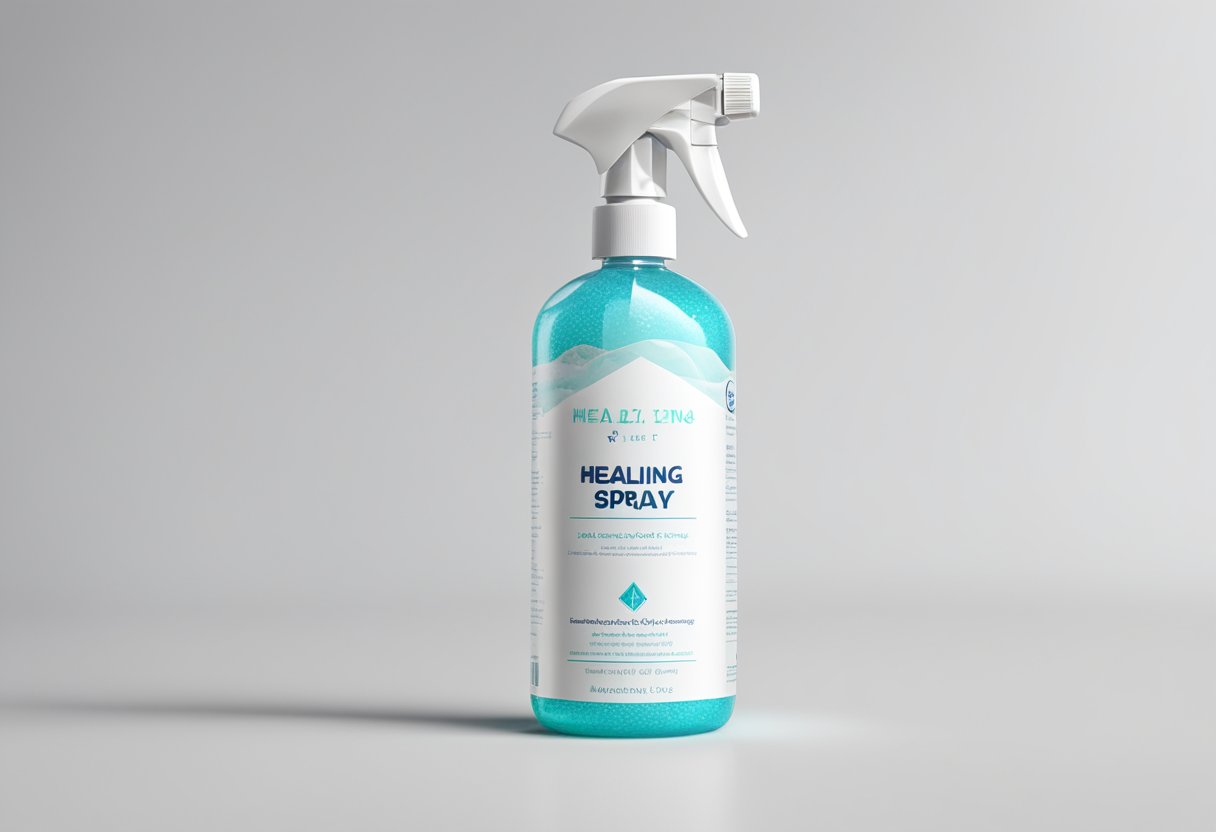
Sea salt has been used for centuries in various beauty recipes and skin therapies. It is known for its ability to exfoliate, unclog pores, and prevent the buildup of excess oil and debris. When combined with water, it can create a healing spray that can help soothe and treat oily skin.
Ingredients List
- 1 cup of warm water
- 1 tablespoon of sea salt
- 1 teaspoon of aloe vera gel
- 2-3 drops of tea tree oil (optional)
Recipe
- Warm up 1 cup of water.
- Add 1 tablespoon of sea salt to the warm water and stir until it dissolves.
- Add 1 teaspoon of aloe vera gel to the saltwater and stir well.
- Add 2-3 drops of tea tree oil to the mixture (optional).
- Pour the mixture into a spray bottle and shake well.
To use, simply spray the mixture onto your face and let it dry naturally. The sea salt and water healing spray can be used as a spot treatment for oily skin, as well as an all-over face mist to refresh and hydrate the skin.
It is important to note that while sea salt and water healing spray can be helpful for oily skin, it should not be used excessively as it can be drying. It is recommended to use it 1-2 times per week for best results.
Overall, sea salt and water healing spray is a simple and effective DIY homemade spot treatment recipe for oily skin that can help soothe and treat breakouts.
Orange Peel and Water Brightening Treatment

Orange peel is an excellent source of vitamin C, which is known to reduce the appearance of dark spots and blemishes. This treatment is perfect for people who are looking for a natural and effective way to brighten their skin. Here is a simple recipe for an orange peel and water brightening treatment.
Ingredients List
- 1 tablespoon of orange peel powder
- 2 tablespoons of water
Recipe
- Mix the orange peel powder and water in a small bowl to form a paste.
- Apply the paste to your face and leave it on for 10-15 minutes.
- Rinse your face with warm water and pat dry.
This treatment can be used once or twice a week for best results. Orange peel is a gentle exfoliant, so it can help to remove dead skin cells and reveal brighter, smoother skin. It is also a natural astringent, which means it can help to tighten pores and reduce the appearance of oiliness.
Overall, the orange peel and water brightening treatment is a simple and effective way to improve the appearance of your skin. It is also affordable and easy to make at home.
Grapefruit Seed Extract and Glycerin Serum

Grapefruit seed extract and glycerin serum is an effective spot treatment for oily skin. Grapefruit seed extract has antimicrobial properties that can help kill bacteria that cause acne. Glycerin, on the other hand, is a humectant that helps keep the skin hydrated and moisturized.
Ingredients
- 1 tablespoon glycerin
- 1 tablespoon grapefruit seed extract
- 1 tablespoon distilled water
Recipe
- In a small bowl, mix together glycerin and grapefruit seed extract.
- Add distilled water to the mixture and stir well.
- Transfer the mixture to a dark glass dropper bottle.
- Apply a small amount of the serum to the affected areas using a cotton swab or your fingertips.
- Allow the serum to dry completely before applying any other skincare products.
This serum can be used once or twice a day, depending on the severity of the acne. It is important to note that grapefruit seed extract can be irritating to some people, so it is recommended to do a patch test before using it on the entire face. Also, this serum should not be used as a replacement for a daily moisturizer.
Cucumber and Lemon Refreshing Spot Corrector
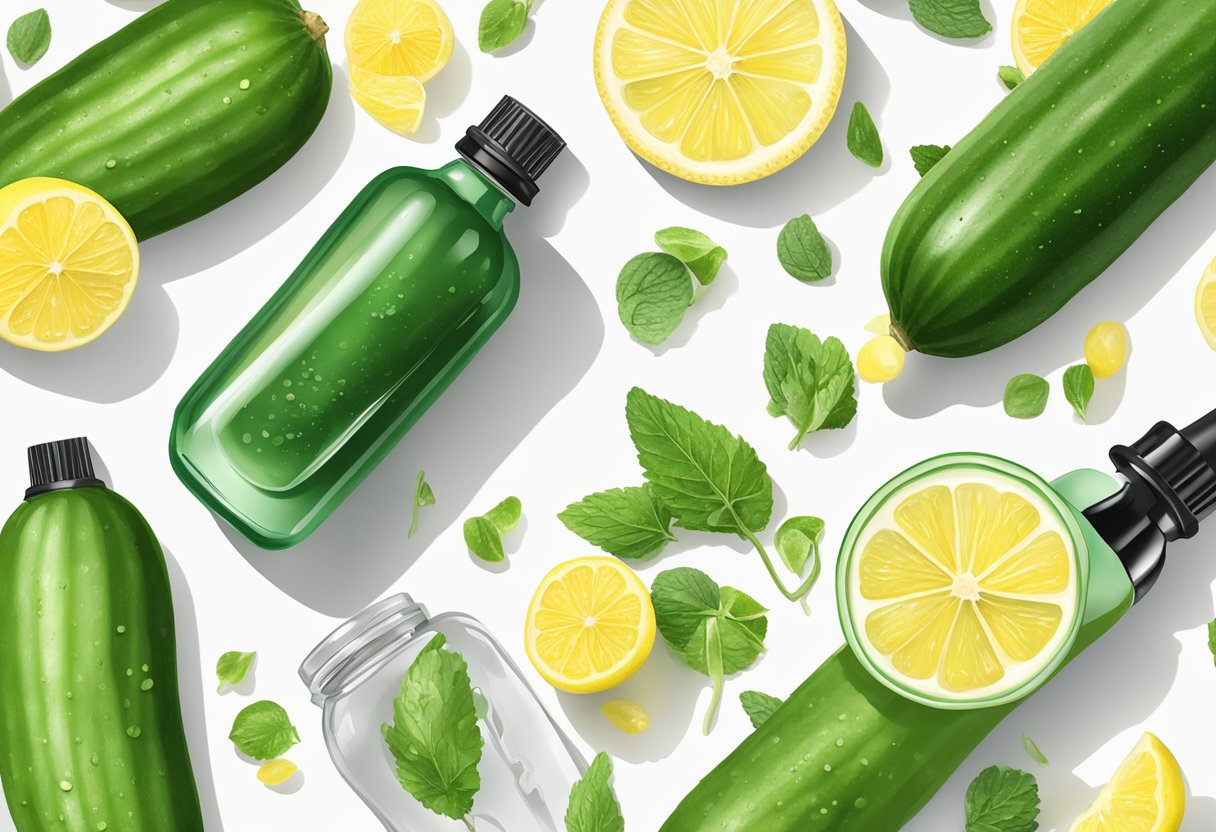
Cucumber is a natural astringent that helps to shrink pores and reduce oiliness. Lemon juice is a natural source of vitamin C and antioxidants that help to brighten skin and reduce the appearance of dark spots. Together, they make a refreshing spot corrector that can help to reduce the appearance of blemishes and improve the overall texture of the skin.
Ingredients List
- 1/2 cucumber, peeled and chopped
- 1 tablespoon fresh lemon juice
- 1 tablespoon witch hazel
- 1 teaspoon honey
Recipe
- Blend the cucumber in a food processor or blender until it is smooth.
- Strain the cucumber juice through a fine mesh strainer to remove any pulp.
- In a small bowl, mix together the cucumber juice, lemon juice, witch hazel, and honey until well combined.
- Apply the mixture to any areas of the skin that have blemishes or dark spots.
- Leave the mixture on the skin for 10-15 minutes.
- Rinse the mixture off with warm water and pat the skin dry.
This refreshing spot corrector can be used once a day to help reduce the appearance of blemishes and improve the overall texture of the skin. It is gentle enough to use on a daily basis and can be stored in the refrigerator for up to one week.
Frequently Asked Questions

What are some homemade face mask recipes specifically for treating oily skin and pimples?
For those with oily skin, it’s important to use ingredients that help reduce oil production and prevent breakouts. A popular DIY face mask recipe for oily skin and pimples is a mixture of honey, lemon juice, and turmeric. Honey is a natural humectant that helps moisturize the skin, while lemon juice has antibacterial properties that can help prevent breakouts. Turmeric is known for its anti-inflammatory properties and can help reduce redness and inflammation in the skin.
Another effective homemade face mask for oily skin is made with egg whites and oatmeal. Egg whites help tighten pores and reduce oil production, while oatmeal helps soothe the skin and absorb excess oil. Simply mix one egg white with 1/4 cup of cooked oatmeal and apply to the face for 15-20 minutes before rinsing off with warm water.
Which ingredients are most effective for a DIY face mask targeting blackheads on oily skin?
Blackheads are a common issue for those with oily skin, but there are several ingredients that can help remove them. One effective DIY face mask for blackheads is made with activated charcoal and bentonite clay. Activated charcoal helps draw out impurities from the skin, while bentonite clay helps absorb excess oil and unclog pores. Mix equal parts activated charcoal and bentonite clay with enough water to form a paste, apply to the face for 10-15 minutes, and rinse off with warm water.
Another effective ingredient for targeting blackheads is apple cider vinegar. Its natural acidity helps dissolve dead skin cells and unclog pores. Mix equal parts apple cider vinegar and water, apply to the face with a cotton ball, and leave on for 10-15 minutes before rinsing off with warm water.
What are the top homemade remedies for reducing excessive oiliness in skin?
Excessive oiliness in the skin can be caused by a variety of factors, including genetics and hormonal changes. However, there are several homemade remedies that can help reduce oil production and keep the skin looking fresh and matte. One effective remedy is a mixture of aloe vera gel and tea tree oil. Aloe vera gel helps soothe the skin and reduce inflammation, while tea tree oil has antibacterial properties that can help prevent breakouts. Mix one tablespoon of aloe vera gel with 2-3 drops of tea tree oil and apply to the face as needed.
Another effective remedy is a toner made with witch hazel and rose water. Witch hazel helps tighten pores and reduce oil production, while rose water helps soothe the skin and reduce redness. Mix equal parts witch hazel and rose water, apply to the face with a cotton ball after cleansing, and allow to dry before applying moisturizer.

